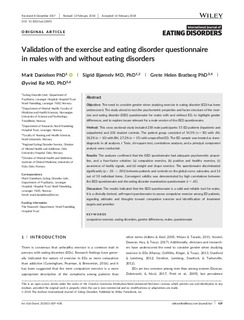| dc.contributor.author | Danielsen, Marit | |
| dc.contributor.author | Bjørnelv, Sigrid | |
| dc.contributor.author | Bratberg, Grete Helen | |
| dc.contributor.author | Rø, Øyvind | |
| dc.date.accessioned | 2018-11-23T13:57:34Z | |
| dc.date.available | 2018-11-23T13:57:34Z | |
| dc.date.created | 2018-06-26T12:17:10Z | |
| dc.date.issued | 2018 | |
| dc.identifier.citation | International Journal of Eating Disorders. 2018, 51 (5), 429-438. | nb_NO |
| dc.identifier.issn | 0276-3478 | |
| dc.identifier.uri | http://hdl.handle.net/11250/2574643 | |
| dc.description.abstract | Objective
The need to consider gender when studying exercise in eating disorder (ED) has been underscored. The study aimed to test the psychometric properties and factor structure of the exercise and eating disorder (EED) questionnaire for males with and without ED, to highlight gender differences, and to explore issues relevant for a male version of the EED questionnaire.
Method
This cross sectional study included 258 male participants: 55 ED patients (inpatients and outpatients) and 203 student controls. The patient group consisted of 54.5% (n = 30) with AN, 18.2% (n = 10) with BN, 27.2% (n = 15) with unspecified ED. The ED sample was treated as transdiagnostic in all analyses. t Tests, chi‐square test, correlations analyses, and a principal component analysis were conducted.
Results
The analyses confirmed that the EED questionnaire had adequate psychometric properties, and a four‐factor solution: (a) compulsive exercise, (b) positive and healthy exercise, (c) awareness of bodily signals, and (d) weight and shape exercise. The questionnaire discriminated significantly (p < .01– < .001) between patients and controls on the global score, subscales, and 16 out of 18 individual items. Convergent validity was demonstrated by high correlations between the EED questionnaire and the eating disorder examination questionnaire (r = .65).
Discussion
The results indicated that the EED questionnaire is a valid and reliable tool for males. It is a clinically derived, self‐report questionnaire to assess compulsive exercise among ED patients, regarding attitudes and thoughts toward compulsive exercise and identification of treatment targets and priorities | nb_NO |
| dc.language.iso | eng | nb_NO |
| dc.publisher | Wiley | nb_NO |
| dc.rights | Attribution-NonCommercial-NoDerivatives 4.0 Internasjonal | * |
| dc.rights.uri | http://creativecommons.org/licenses/by-nc-nd/4.0/deed.no | * |
| dc.title | Validation of the exercise and eating disorder questionnaire in males with and without eating disorders | nb_NO |
| dc.title.alternative | Validation of the exercise and eating disorder questionnaire in males with and without eating disorders | nb_NO |
| dc.type | Journal article | nb_NO |
| dc.type | Peer reviewed | nb_NO |
| dc.description.version | publishedVersion | nb_NO |
| dc.source.pagenumber | 429-438 | nb_NO |
| dc.source.volume | 51 | nb_NO |
| dc.source.journal | International Journal of Eating Disorders | nb_NO |
| dc.source.issue | 5 | nb_NO |
| dc.identifier.doi | 10.1002/eat.22855 | |
| dc.identifier.cristin | 1593972 | |
| dc.description.localcode | © 2018 The Authors International Journal of Eating Disorders Published by Wiley Periodicals, Inc. This is an open access article under the terms of the Creative Commons Attribution‐NonCommercial‐NoDerivs License | nb_NO |
| cristin.unitcode | 194,65,35,0 | |
| cristin.unitname | Institutt for psykisk helse | |
| cristin.ispublished | true | |
| cristin.fulltext | original | |
| cristin.qualitycode | 2 | |

